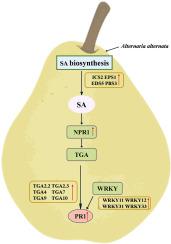梨果实TGA基因家族的全基因组鉴定和综合表征及其在应对互花霉侵染中的潜在作用
IF 3.3
3区 农林科学
Q2 PLANT SCIENCES
引用次数: 0
摘要
黑斑病是一种影响梨果实生产的全球性重大病害。TGACG基序结合因子(TGA)转录因子是亮氨酸拉链基区(bZIP)家族的成员,在植物对病原体的防御机制中起着至关重要的作用。本研究对梨中TGA基因进行了系统筛选和鉴定,并进一步探讨了TGA基因在梨对黄霉侵染反应中的潜在作用。结果表明,梨具有10个TGA基因,分布在9条染色体上,位于细胞核内。系统发育分析表明,10个TGA基因可分为5个不同的类群,每个类群具有一致的结构特征和基序组成。顺式调控元件的预测表明,PbTGAs参与了对各种激素和环境刺激的响应,并参与了生长发育过程。此外,RT-qPCR分析显示,在草霉感染后,PbTGA2.2、PbTGA2.3、PbTGA4、PbTGA7、PbTGA9和PbTGA10的表达水平发生了显著变化。此外,黄花霉侵染可上调雪梨果实中PbWRKY11/12/31/33、PbICS2、PbEPS1、PbEDS5、PbPBS3、PbNPR1和PbPR-1的表达水平。这些结果表明,PbTGA基因在水杨酸信号通路中发挥作用,参与了梨抗水杨酸的作用。本文章由计算机程序翻译,如有差异,请以英文原文为准。

Genome-wide identification and comprehensive characterization of the TGA gene family in pear fruit and their potential roles in response to Alternaria alternata infection
The black spot, caused by Alternaria alternata, represents a globally significant disease affecting pear fruit production. TGACG motif-binding factor (TGA) transcription factors, which are members of the basic region leucine zipper (bZIP) family, play a vital role in the defense mechanisms of plants against pathogens. This study systematically screened and characterized TGA genes in pears, and further investigated their potential roles in response to A. alternata infection. The results demonstrated that pears possess 10 TGA genes, which are distributed across 9 chromosomes and located in the nucleus. Phylogenetic analysis revealed that the 10 TGA genes can be classified into five distinct groups, each characterized by consistent structural features and motif compositions. The prediction of cis-regulatory elements indicates that PbTGAs are involved in responses to various hormones and environmental stimuli, as well as in growth and developmental processes. In addition, RT-qPCR analysis demonstrated that PbTGA2.2, PbTGA2.3, PbTGA4, PbTGA7, PbTGA9, and PbTGA10 showed significant changes in expression levels following A. alternata infection. Furthermore, A. alternata infection was found to up-regulate the expression levels of PbWRKY11/12/31/33, PbICS2, PbEPS1, PbEDS5, PbPBS3, PbNPR1, and PbPR-1 in Snow pear fruit. These results indicate that PbTGA genes play a role in the salicylic acid signaling pathway, contributing to resistance against A. alternata in pears.
求助全文
通过发布文献求助,成功后即可免费获取论文全文。
去求助
来源期刊
CiteScore
4.30
自引率
7.40%
发文量
130
审稿时长
38 days
期刊介绍:
Physiological and Molecular Plant Pathology provides an International forum for original research papers, reviews, and commentaries on all aspects of the molecular biology, biochemistry, physiology, histology and cytology, genetics and evolution of plant-microbe interactions.
Papers on all kinds of infective pathogen, including viruses, prokaryotes, fungi, and nematodes, as well as mutualistic organisms such as Rhizobium and mycorrhyzal fungi, are acceptable as long as they have a bearing on the interaction between pathogen and plant.

 求助内容:
求助内容: 应助结果提醒方式:
应助结果提醒方式:


